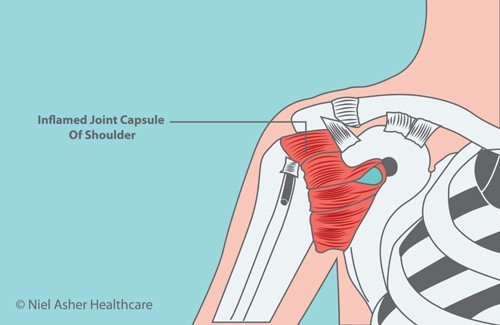by Diana Khoury
Frozen shoulder is a disabling condition characterized by pain, inflammation, stiffness and limited range of motion in the shoulder joint. The first symptoms are pain and an inability to perform daily tasks such as reaching or lifting. Shoulder function may be restricted for months or years, depending on the severity and course of treatment sought. Triggered by minor injury or improper movement (such as reaching backward from an abnormal position), the onset of frozen shoulder is gradual. Bodywork is often recommended as primary treatment for frozen shoulder – to improve function of the joint, reduce pain and facilitate increased range of motion.

Frozen shoulder currently affects around 5% of the population. However, the condition is 5 times more common in Type I and II Diabetics, possibly due to elevated blood sugar levels, which cause increased stiffness (glycosylation) in connective tissues over time.1
Those additionally at risk for incidents of frozen shoulder include:
- Individuals between the ages of 40-65
- Women (60-70% of cases)
- People with poor posture
- Those engaged in regular overuse of shoulder muscles (in sports, manual labor, etc.)
- People with recent shoulder injuries
- Patients recovering from shoulder or reconstructive breast surgeries
- Family members with a history of frozen shoulder issues (genetic component)1
The onset of frozen shoulder is gradual and symptoms may last from 1-2 months to over 3 years, depending on treatment. Once a frozen shoulder is treated and healed, recurrence is uncommon. However, a small percentage of patients develop it in the opposite shoulder within 5 years.
There are three identified stages of frozen shoulder:
The acute stage (lasting 2-9 months), is characterized mainly by pain, limited range of motion, and interruption of sleep due to increased pain at night.2
The subacute or “frozen” stage (4-12 months) is marked by reduction in pain, increased stiffness and severely restricted range of motion.
The chronic or “thawing” stage (12-42 months) is the beginning of recovery, where pain is gone and range of movement gradually starts to improve.3
Since many shoulder problems are misdiagnosed as frozen shoulder, a proper evaluation should be performed by a medical professional to determine the most appropriate course of treatment.4
The standard medical treatment approach may include anti-inflammatory medications, cortisone injections, forced shoulder joint manipulations under anesthesia, or in the most extreme cases, surgery.3
A more conservative approach to frozen shoulder treatment includes manual therapy, bodywork and exercises, and is often recommended as a primary course before more invasive treatments are entertained.
Acupuncture used in conjunction with exercises have been shown to be an effective treatment for frozen shoulder.5Acupuncture releases endorphins which act as pain inhibitors, and stimulates the body’s natural healing abilities. The Healthcare Medicine Institute reports new research out of China and Germany that concludes acupuncture can release frozen shoulder pain and improve joint function and range of motion by targeting specific points related to muscle release in the shoulder capsule.6
Therapeutic massage techniques such as trigger point therapy, myofascial release, stretching and joint mobilization can be applied individually or in combination to address frozen shoulder, with positive results.7
For maximum effectiveness, therapeutic massage techniques are applied in moderation to break down adhesions (stiffness) in the shoulder joint, increase circulation (of blood, oxygen, synovial fluid), release locked muscles, and facilitate movement. Depending on which phase of frozen shoulder the patient is in, the massage therapist can design a series of therapeutic sessions to continue to unlock and unwind the stiffness in the shoulder, improve function and gradually restore normal range of motion.
This is an original article from Dreamclinic, Inc. Dreamclinic is a Health and Wellness company committed to sharing information about commonly experienced health conditions and how they may be impacted through the use of bodywork and other natural approaches. Dreamclinic offers massage, acupuncture, and Reiki sessions at its Greenlake and Queen Anne clinics, as well as onsite massage at workplaces around Puget Sound. Contact us to learn more about how Dreamclinic can help you, your family or your workplace experience greater health.
References:
1. www.frozenshoulder.com
2. http://www.massageworld.co.uk/articles/sports-massage-getting-the-frozen-shoulder
3. http://www.ncbi.nlm.nih.gov/pubmedhealth/PMH0047043/
4. http://www.massagetoday.com/mpacms/mt/article.php?id=10941
5. http://www.ncbi.nlm.nih.gov/pubmed/11773673
6. http://www.healthcmi.com/Acupuncture-Continuing-Education-News/1214-acupuncture-unlocks-frozen-shoulder-pain-new-research
7. http://www.ncbi.nlm.nih.gov/pmc/articles/PMC3096148/
Other Resources:
http://acupuncturetoday.org/mpacms/at/article.php?id=28032
